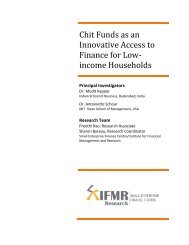Government of India Volume I: Analysis and Recommendations
Government of India Volume I: Analysis and Recommendations
Government of India Volume I: Analysis and Recommendations
You also want an ePaper? Increase the reach of your titles
YUMPU automatically turns print PDFs into web optimized ePapers that Google loves.
14.2. Problems <strong>of</strong> the present arrangements<br />
FINANCIAL REGULATORY ARCHITECTURE<br />
At present, <strong>India</strong> has a legacy financial regulatory architecture. The present work allocation<br />
– between RBI, SEBI, IRDA, PFRDA, <strong>and</strong> FMC – was not designed; it evolved over the<br />
years, with a sequence <strong>of</strong> piecemeal decisions responding to immediate pressures from<br />
time to time.<br />
The present arrangement has gaps for which no regulator is in charge – such as the<br />
diverse kinds <strong>of</strong> ponzi schemes that periodically surface in <strong>India</strong>, which are not regulated<br />
by any <strong>of</strong> the existing agencies. It also contains overlaps where conflicts between regulators<br />
has consumed the energy <strong>of</strong> top economic policy makers <strong>and</strong> held back market<br />
development.<br />
Over the years, these problems will be exacerbated through technological <strong>and</strong> financial<br />
innovation. Financial firms will harness innovation to place their activities into the<br />
gaps, so as to avoid regulation. When there are overlaps, financial firms will undertake<br />
forum-shopping, where the most lenient regulator is chosen, <strong>and</strong> portray their activities<br />
as belonging to that favoured jurisdiction.<br />
An approach <strong>of</strong> multiple sectoral regulators that construct ‘silos’ induces economic<br />
inefficiency. At present, many activities that naturally sit together in one financial firm are<br />
forcibly spread across multiple financial firms, in order to suit the contours <strong>of</strong> the <strong>India</strong>n<br />
financial regulatory architecture. Financial regulatory architecture should be conducive<br />
to greater economies <strong>of</strong> scale <strong>and</strong> scope in the financial system. In addition, when the<br />
true activities <strong>of</strong> a financial firm are split across many entities, each <strong>of</strong> which has oversight<br />
<strong>of</strong> a different supervisor, no single supervisor has a full picture <strong>of</strong> the risks that are present.<br />
Fragmentation <strong>of</strong> financial firms, which responds to fragmentation <strong>of</strong> financial regulation,<br />
leads to a reduced ability to underst<strong>and</strong> risk.<br />
When a regulator focuses on one sector, certain unique problems <strong>of</strong> public administration<br />
tend to arise. Assisted by lobbying <strong>of</strong> financial firms, the regulator tends to share<br />
the aspirations <strong>of</strong> the regulated financial firms, such as low competition, preventing financial<br />
innovation in other sectors, high pr<strong>of</strong>itability, <strong>and</strong> high growth. These objectives<br />
<strong>of</strong>ten conflict with the core economic goals <strong>of</strong> financial regulation such as consumer protection<br />
<strong>and</strong> swift resolution.<br />
Reflecting these difficulties, the present <strong>India</strong>n financial regulatory architecture has,<br />
over the years, been universally criticised by all expert committee reports. The Commission<br />
has analysed the recommendations for reform <strong>of</strong> financial regulatory architecture<br />
<strong>of</strong> all these expert committee reports <strong>and</strong> weighed the arguments presented by each <strong>of</strong><br />
them.<br />
14.3. Considerations that guide alternative architecture<br />
choices<br />
In order to analyse alternative proposals in financial regulatory architecture, the Commission<br />
established the following principles:<br />
Accountability: Accountability is best achieved when an agency has a clear purpose.<br />
The traditional <strong>India</strong>n notion that a regulator has powers over a sector but lacks<br />
specific objectives <strong>and</strong> accountability mechanisms is unsatisfactory.<br />
Conflicts <strong>of</strong> interest: In particular, direct conflicts <strong>of</strong> interest are harmful for accountability<br />
<strong>and</strong> must be avoided.<br />
A complete picture <strong>of</strong> firms: A financial regulatory architecture that enables a comprehensive<br />
view <strong>of</strong> complex multi-product firms, <strong>and</strong> thus a full underst<strong>and</strong>ing <strong>of</strong> the risks<br />
that they take, is desirable.<br />
132 FINANCIAL SECTOR LEGISLATIVE REFORMS COMMISSION



